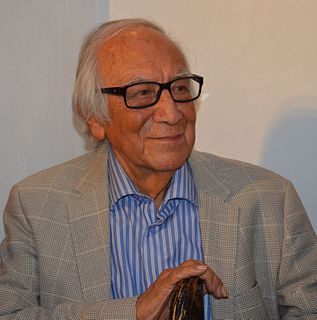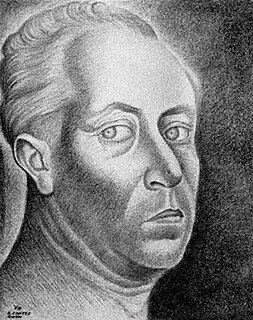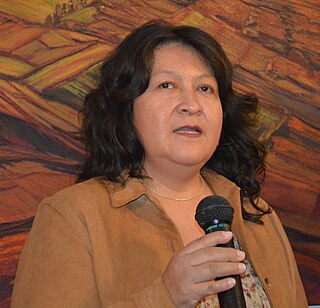
Geles Cabrera Alvarado (born August 2, 1929 in Mexico City) is a Mexico City sculptor who has worked in a variety of materials, there is a museum dedicated to her work in the south of the city. [1]

Geles Cabrera Alvarado (born August 2, 1929 in Mexico City) is a Mexico City sculptor who has worked in a variety of materials, there is a museum dedicated to her work in the south of the city. [1]
Geles Cabrera was born in Mexico City to Salvador Cabrera and Jovita Alvarado. [2] Her father was a civil engineer and the owner of a factory that made paper mache decorations in art nouveau style for upper-class homes. Two of her aunts were recognized artists: Rosario Cabrera, a painter who worked with the art schools promoted by José Vasconcelos and Consuelito Cabrera, a soprano. [3]
Her interest in art began young and was encouraged by the family. [3] Geles’ interests include music well as art, studying both dance and visual arts. From 1943 to 1947, she studied mornings at the Academy of San Carlos, and in the afternoons/evenings, she studied classical and folk dance at the Escuela de Danza, which was at the Abelardo L. Rodriguez Market. [2] [3] In 1947, her father had to close the factory and the family moved to Cuba, where he worked building bridges. In this country, she continued her art studies at the San Alejandro Academy, where she met Wifredo Lam. In 1948 and 1949, she won second then first place at the Salón de Bellas Artes in Havana. [2] [3]
The family returned to Mexico in 1949, and Geles enrolled into Escuela Nacional de Pintura, Escultura y Grabado "La Esmeralda". During this time, movie actress Dolores del Río decided to pose for a select group of students, with Geles being one. The artist created a bust that pleased the actress’s mother and which accompanied Del Río during her career. [3] Cabrera married physician Rafael Cano, who supported her work during the sixty five years of marriage. The couple had five children: Salvador, Erika, Irma, Iris and Rafael. [3] She still lives and works in Mexico City.
She had her first individual exhibition at the Mont Orendaín Gallery (Colonia Roma) in 1949. [2] [3] [4] Paul Westheim, commenting about the exhibit, said, “Lehmbruck, Brancusi, Lipschitz, Moore: Geles has placed herself among them.” [2] Over her career, Cabrera has had over twenty two individual exhibitions and has participated in over fifty collective ones. [3] These include two exhibits in 2009 in the Coyoacán metro station (Line 3) and in the Botanical Garden of the Mexican National Autonomous University (UNAM). [2] She has published three books, [3] and in 1975 was a founding member of GUCADIGOSE along with Ángela Gurría, Juan Luis Diez, Mathias Goeritz and Sebastian. Later the group became BACADIGUGOSETA with the addition of Herbert Bayer de la Bauhaus y Tamayo. The aim of the group was to make three dimensional work within an urban setting. [1] [3] She has received awards and other recognition in Mexico and abroad, in countries such as Belgium, Bulgaria, the United States, Cuba and Israel. [3] Her work has been written about by critics such as Paul Westheim, Margarita Nelken, Antonio Rodríguez, María Luisa Mendoza, Raquel Tibol and Makario Matus. [3] In 1949, she received first prize in the thirty-first Fine Arts Salon of Havana and in 1985, she was granted first prize in sculpture in Gabrovo, Bulgaria. [2] She was invited to become a member of the Salón de la Plástica Mexicana in 1949, [3] and she appeared in the documentary Escultura es cultura, along with Feliciano Bejar, Pedro Cervantes, Antonio Nava and others. [5] She dedicated 37 years to teaching art in the José Vasconcelos National Preparatory School No. 5, part of the National Autonomous University of Mexico. [2] Examples of her work can be found in the Geles Cabrera Sculpture Museum of Art in Coyoacán, Mexico City. [6] Ceramist Irma Peralta was among her pupils. [7]
Her sculpture focuses on the female body in modular shapes. [8] Common themes include love, loneliness and being a mother. First working in clay, metal and stone based on prehistoric art, she uses clear lines to emphasize the human form´s eroticism. Later, she began using newspaper as an artistic material. [1]
In 1966 she founded a free museum for sculpture called the Museo Escultório, next to her husband’s clinic. She maintained this museum for forty years with her earnings from teaching. [3] Today it is the Museo Escultórico Geles Cabrera, the first museum dedicated to sculpture from the Americas, but it is practically unknown. It contains a permanent collection of Mexican sculpture in various materials including sixty pieces by Cabrera from 1948. Cabrera describes the museum as “the communication of art and sculpture to the people, to the community. Here there are no signs that say “don’t touch.” One of the touchable sculptures is a swing, which when ridden produces a human heartbeat. Many of the museum’s visitors are children coming as part of classes from school. [9]

Arturo García Bustos was a Mexican painter and print maker. He is known as one of “Los Fridos” students who studied under Frida Kahlo at her home in Coyoacán.

Ángela Gurría Davó is a Mexican sculptor. In 1974, she became the first female member of the Academia de Artes. She is best known for her monumental sculptures such as Señal, an eighteen meter tall work created for the 1968 Summer Olympics. She lives and works in Mexico City.

María Luisa Reid is a Mexican artist from Zacatepec in the state of Morelos. She is a member of the Salón de la Plástica Mexicana.

Deyanira África González Melo is a Mexican sculptor who generally works in ceramics, depicting elements of the human form, especially the torso, generally with mutilations and other disturbing elements to dispute the otherwise traditional and sensual depictions of the human body. She has exhibited her work since studying at the Escuela Nacional de Artes Plásticas (ENAP) in Mexico as well as in Europe and the Caribbean. Her work has received recognition in Mexico and abroad, and is a member of the Salón de la Plástica Mexicana.
Rosa Castillo Santiago was a Mexican sculptor, and founding member of the Salón de la Plástica Mexicana.

Erasto Cortés Juárez was a Mexican artist and a founding member of the Salón de la Plástica Mexicana.
Andrea Gómez y Mendoza was a Mexican graphic artist and muralist, a member of the Salón de la Plástica Mexicana.
Lourdes Alaniz is a Mexican painter and graphic artist whose work has been recognized with exhibition in Mexico’s Salón de la Plástica Mexicana.

Chappie Angulo is an American-Mexican painter and illustrator whose work has been recognized with membership in Mexico’s Salón de la Plástica Mexicana.
Rocio Caballero is a Mexican figurative painter, whose works often depict mythical worlds and are noted for her use of symbolism. Her work has been exhibited individually and collectively in Mexico, the United States, South America and Europe and can be found in collections such as that of the National Museum of Mexican Art. Her work has been recognized with membership in the Salón de la Plástica Mexicana.
Yolanda Cabrera is a Mexican artist who was a graphic designer for twenty years before turning to the fine arts. Her work shows influence from her former profession along with the use of personal symbolism and experimentation in both materials and techniques. Cabrera’s work has been shown regularly in Mexico City and other parts of the country and has been recognized by the Salón de la Plástica Mexicana.
Susana Campos is a Mexican artist whose work tends to be complex compositions in various media generally introspective or commentary on society. She has had over thirty five individual exhibitions in Mexico and participated in various collective exhibitions in Mexico and abroad. Her work has been recognized with membership in the Salón de la Plástica Mexicana since 1966, and has been written about by various noted art writers in Mexico.

Angelica Carrasco is a Mexican graphic artist who is a pioneer of large scale printmaking in the country. Her work often is related to violence and classified as “abstract neo-expressionism.” Much of her career has been dedicated to teaching and the promotion of the arts, especially the graphic arts and has been recognized with membership in the Salón de la Plástica Mexicana and the Sistema Nacional de Creadores de Arte.
Beatriz Caso Lombardo was a Mexican sculptor, whose works were recognized with membership in the Salón de la Plástica Mexicana.
Consuelo González Salazar is a Mexican painter whose work has been recognized with membership in the country’s Salón de la Plástica Mexicana.
Patricia Mejía Contreras was a Mexican sculptor and graphic artist whose work was recognized with membership in the Salón de la Plástica Mexicana.
Flor Minor is a Mexican sculptor and graphic artist, known for bronze sculptures and graphic work that generally depict the male form. Her works often are based on the concept of balance or lack thereof. Minor has had individual exhibitions in notable venues in Mexico and abroad, and her work can be found in a number of public and private collections. She has been recognized in Mexico with membership in the Salón de la Plástica Mexicana.
Yolanda Quijano is a Mexican painter and sculptor whose work has been recognized with membership in the Salón de la Plástica Mexicana.
Noemí Ramírez is a Mexican visual artist, whose work has been recognized with several honors including membership in the Salón de la Plástica Mexicana.

Ruth Rivera Marín was a Mexican architect. Her professional experience centered on teaching, institutional management, theory and practice related to architecture. She was the first woman student of the College of Engineering and Architecture at the National Polytechnic Institute.